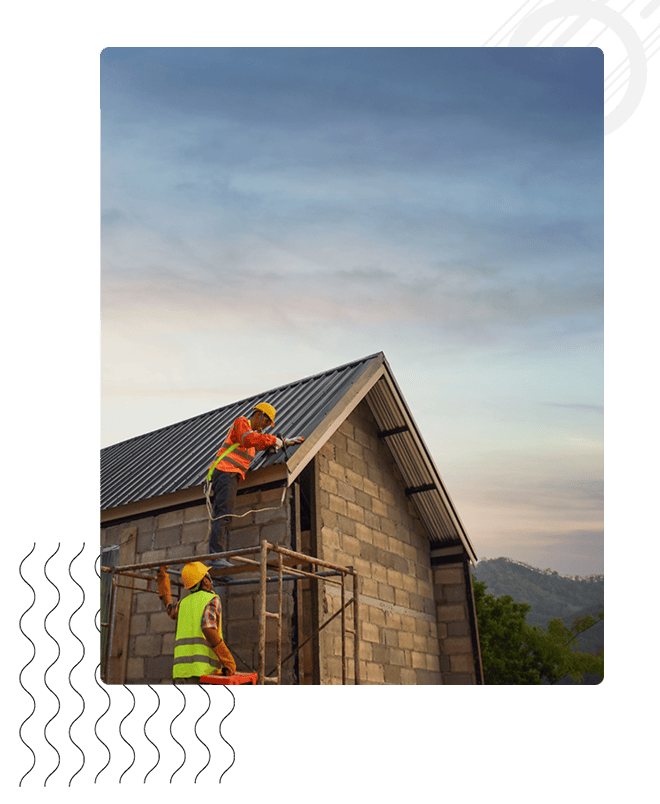Roofs provide an essential protection from the elements for homes and other buildings. Understanding the common roofing issues is a necessary skill for anyone responsible for maintaining or replacing roofs.
This article will decode some of these common roofing issues, exploring their causes and potential solutions.
In order to identify and address roofing problems in a timely manner, it is important to be aware of the signs that indicate there may be an issue with your roof’s structure or material integrity.
The information provided in this article can help individuals recognize problem areas so they can take corrective action when needed.
Leaks
Roof leaks are a common issue in many dwellings, and can be caused by various factors. Damaged flashing is one of the main causes, as it compromises the seal between two separate parts of the roof or around chimney stacks. This allows water to enter and cause damage to the home’s interior walls, ceilings, and insulation.
Another problem that may arise from weather conditions is ice damming. When there is inadequate ventilation and poor insulation, snow accumulates on the roof edge creating an ice blockage, which then induces melting which leads to leakage inside the structure. In order for this to be avoided, adequate sealing measures must be taken prior to winter season.
Additionally, soffit vents should also be installed as they allow air circulation throughout the attic space diminishing further issues related with moisture accumulation.
Blistering And Peeling
Leaking roofs can lead to more serious issues, such as blistering and peeling.
Blistering involves the formation of bubbles on the roof surface, which are caused by trapped moisture between two layers of shingles or other roof material. This often occurs when water penetrates through a crack in one layer causing it to expand and separate from another layer.
When an area is not properly ventilated or sealed, it can also cause blisters due to heat buildup within the space. If left untreated for long periods of time, blistering can lead to further damage like mold growth and increased water infiltration into your home’s internal structure.
Peeling typically occurs when a sealer fails to adhere correctly or has been applied incorrectly. Poor adhesion generally happens with aged materials that have become brittle over time or with new materials that were improperly installed.
As with any problem related to your roof, prevention is key; regular inspections will help you catch these issues before they become too severe. Proper maintenance and repair methods should be employed quickly in order to avoid expensive repairs down the road.
Cracking
Cracking is a common issue when it comes to roofing. It can be caused by anything from crumbling mortar joints, weather or ice damage, and even expanding and contracting temperatures.
The cracking of the surface material does not always indicate structural issues, however if left untreated could lead to more serious problems such as water ingress.
To prevent further deterioration in all circumstances, addressing any cracks should be done as soon as possible regardless of severity. This will help maintain the integrity of the structure while also aiding in extending its life expectancy.
Depending on the cause of the crack, materials like sealant may be sufficient enough for repair with minimal effort; otherwise an experienced professional may need to be consulted depending on how severe the problem is.
Missing Shingles
Cracking is just one of the common issues found in roofing. Another issue that can arise is missing shingles, typically caused by strong winds or hail damage.
Shingles may also become loose due to moss growth on the surface of the roof, which can cause them to detach from their original position and fall off completely. Missing shingles can leave your home susceptible to further weather damage such as heavy rains, snowfall or even sun exposure if left unchecked for long enough periods of time.
In order to prevent water seepage into the structure it’s important to repair any damage right away before it causes further problems down the line. To ensure a thorough job fixing each individual problem, an experienced professional with knowledge in all aspects of roofing should be consulted so they can properly identify and address every necessary detail.
Sagging
Sagging of roofing structures is a common issue that can be caused by various factors, including improper waterproofing and ice dams.
Without the proper care and maintenance of a roof system, its structural integrity may become compromised due to sagging.
This can lead to water leakage inside of homes or buildings as well as other potential damages.
Waterproofing helps protect roofs from moisture damage and provides an additional layer of protection against sagging.
It is important for homeowners to ensure their roof systems are properly waterproofed in order to prevent future issues down the road.
Additionally, it’s essential to check for any signs of ice dam formations on roof surfaces during colder months, since they too can cause problems with sagging over time if left untreated.
Taking proactive steps such as these will help reduce risk associated with this type of problem.
Rotting
Sagging can be an indicator of serious roof issues, but it is not the only sign that something is wrong.
Rotting, another common indication of a problem with the roof, often occurs due to water damage and mold growth. The presence of rot indicates that there has been prolonged exposure to moisture which can lead to significant structural degradation if left unaddressed.
In many cases, rotting may appear as discoloration or flaking in certain areas of the roof surface; however, this can also present as missing shingles or tile pieces.
It’s important for homeowners to take preventative measures against potential water damage and mold growth by regularly inspecting their roofs and making necessary repairs promptly – even before obvious signs become visible.
If any evidence of rotting appears on the roof surface, a professional should be consulted immediately so that appropriate action can be taken to address the issue quickly and safely. Taking these steps will ensure long-term protection from costly repairs caused by water infiltration or other damages resulting from neglect.
Poor Ventilation
Poor ventilation in a roofing system can lead to several common issues, including poor insulation and ice damming.
Poorly ventilated roofs are unable to adequately cool the building envelope resulting in an increase of attic temperatures. This causes heat from within the home to be released through the roof instead of being trapped inside where it is intended.
Consequently, this excess heat can cause shingles to become brittle and break down over time leading to water leakage and other moisture-induced damage.
Ice damming is another issue that arises when there is inadequate ventilation. As snow melts on poorly insulated roofs, warmth rises towards the ridge line and heats up cold sections of the eaves causing any remaining snow or ice to melt faster than normal.
When runoff reaches cooler eaves, it refreezes creating an accumulation of ice at lower points along the roof edge which eventually blocks drainage pathways leading to further buildup and possible structural damage due to excessive weight loads.
In order prevent these issues, proper attic ventilation must be established by installing adequate intake vents near soffits and exhaust vents at roof ridges.
Conclusion
The roof is an essential part of a home, and it’s important to know how to identify common roofing issues before they become costly.
Leaks, blistering and peeling, cracking, missing shingles, sagging, rotting, and poor ventilation are all potential problems that can occur over time if the roof isn’t properly maintained.
It is necessary for homeowners to be aware of these issues in order to ensure their roofs stay in good condition.
Regular inspections should be conducted regularly by certified professionals who have experience with identifying any issue that may arise.
Taking the proper steps now will help prevent future roofing disasters from occurring.














